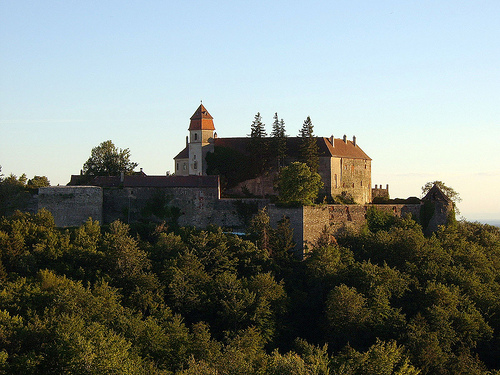

Location: Bernstein, Burgenland Map
Constructed: 1199
Official site
Email: burgbernstein@netway.at
High above the Tauchtal, it is the highest castle in Burgenland.
Bernstein Castle is a medieval citadel constructed in a twelfth
century. Over several centuries its was increased in size and
rebuilt several times. Bernstein Castle stands on a strategic hill
in Bernstein im Burgenland in Austria. Bernstein Castle was
constructed in 1199. Bernstein Castle changed hands several times
and experienced numerous remodeling and reconstructions to fit taste
of new owners. In the 16th century it was proved to be a formidable
citadel against sieges of Ottoman Turkish army. Turkish armies tried
to capture it in 1529 and 1532. In 1604 Bernstein Castle was again
besieged by a joint force of Ottoman Turks, Tatar allies and
Hungarian forces under leadership of Stephen Bocskay. Their attacks
were proven as futile.
In the 17th century Bernstein Castle
lost much of its strategic military importance, but it still served
as a private residence. In 1617 Ludwig Konigsberg rebuilt parts of
the citadel in a more peaceful Baroque style. Parts of the old
defenses were torn down including the keep and several towers.
Currently Bernstein Castle is owned by Eduard von Almásy with a part
of the compound turned into a hotel.
In the year 860 AD the whole area belonged to the Archdiocese of
Salzburg. Erimbert, a vassal of the archbishop, handed over the land on
the Pinka to his servant, "Miles" Jacobus. The place name Rettenbach has
not yet been mentioned, but the old Slavic name of the nearby hamlet of
Grodnau = the village belonging to the castle indicates that there was
already a castle nearby, and it can only have been amber.
From
1199 the castle already belonged to the Kingdom of Hungary. The Miczbán
de genere Akos was named as the owner. It is not known exactly when the
castle passed to Duke Frederick II of Austria and how long it lasted,
but in 1236 Bela IV of Hungary conquered the castle. Years later (1260)
he gave it to Count Heinrich II von Güns.
In 1336, the Counts of
Güssing and von Bernstein were decisively defeated by the Hungarian King
Karl Robert von Anjou, and Bernstein Castle was then confiscated as a
Hungarian crown estate. In 1388 the castle was mortgaged to the Kanizsay
family. In 1389 they began to rebuild the ruined castle. In 1392 the
castle became the property of the Kanizsay family.
Almost a
hundred years later (1482) the castle temporarily came into the
possession of Matthias Corvinus, King of Hungary. After a few years,
Hans von Königsberg received the castle in 1487 as a pledge from Emperor
Friedrich III.
In 1529 and 1532 the Turks besieged the castle but
could not take it. The bastion wreath was then erected in order to
convert the castle into a refuge.
In 1604, Bernstein Castle was
unsuccessfully besieged for weeks by a combined army of Hungarians,
Turks and Tatars under Stephan Bocskay. Ludwig Königsberg had the Gothic
interior of the castle baroque-style in 1617, and the keep and towers
were removed. A little later, in 1644, Ehrenreich Christoph Königsberg
sold the manor and castle to Count Ádám Batthyány. Almost two hundred
years later (1864) Gusztáv Batthyány sold the castle to his
administrator Edward O'Egan. O'Egan's heirs sold the castle to Eduard
von Almásy in 1892. A well-known member of this family was the pilot and
desert explorer Ladislaus Almásy. The castle is still owned by the
Almásy family today. In 1953 part of the castle was converted into a
comfortable holiday hotel.
According to legend, the castle is
haunted by the White Lady of Amber.
The sprawling
building was besieged by the Turks in 1529 and 1532. Since it withstood
the sieges, it was converted into a refuge. The building was damaged by
an explosion of the powder magazine in 1617 and then baroque styled.
Worth seeing is the knight's hall from the first half of the 17th
century, which has a magnificent stucco ceiling.
The castle is a
hotel with a restaurant (registration required). The alchemist's kitchen
and the torture chamber from the 16th century with museum exhibits can
be visited.
In 1978, parts of the film Das Lustschloß im Spessart by Walter Krüttner were shot in Bernstein Castle.